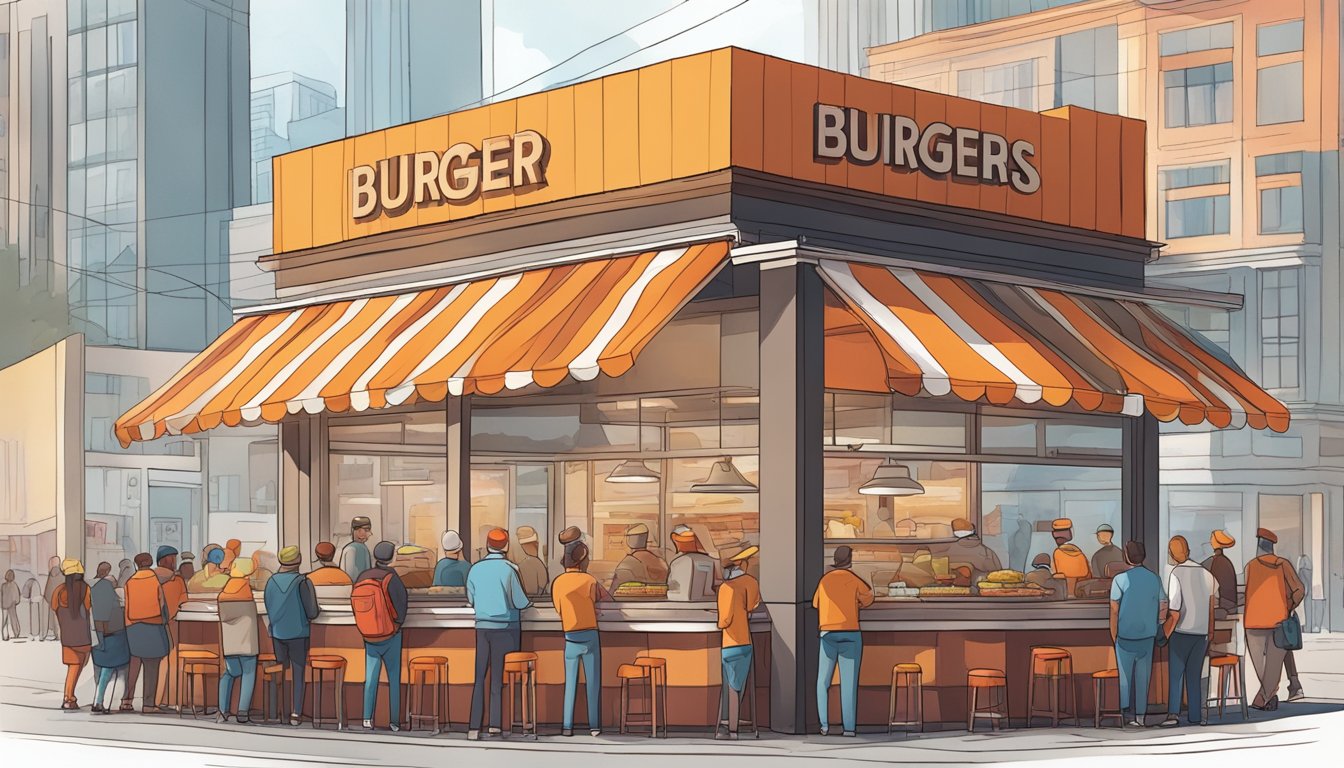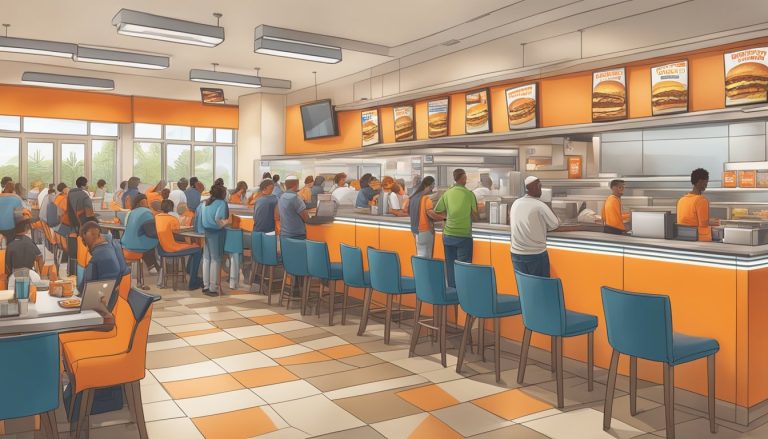Whataburger’s journey from a small burger stand to a beloved breakfast icon began on August 8, 1950, in Corpus Christi, Texas. Harmon Dobson, the visionary founder, set out to create a burger so large it required two hands to hold and so delicious it would make customers exclaim, “What a burger!”
Dobson’s simple yet ambitious vision laid the foundation for Whataburger’s transformation into a fast-food empire with over 900 locations across the United States. The original menu featured only burgers, chips, and drinks, but Whataburger quickly expanded its offerings to include french fries and fried pies in 1962.
As Whataburger grew, it became more than just a burger joint. The chain’s commitment to fresh, made-to-order food and its iconic A-frame restaurant design, introduced in 1961, helped solidify its status as a Texas treasure. Today, Whataburger is renowned not only for its burgers but also for its breakfast menu, cementing its place as a breakfast icon in the fast-food industry.
The Founding of Whataburger
Whataburger’s origins can be traced back to a single burger stand in Corpus Christi, Texas. The vision of entrepreneur Harmon Dobson and his partner Paul Burton laid the foundation for what would become an iconic fast-food chain.
Harmon Dobson’s Vision
Harmon Dobson dreamed of creating a burger so big it would take two hands to hold and so good that customers would exclaim “What a burger!” This vision drove him to develop a unique product that stood out in the fast-food landscape.
Dobson focused on quality ingredients and generous portions. He insisted on using 100% pure beef patties and larger, 5-inch buns. This commitment to size and quality became a hallmark of the Whataburger brand.
The entrepreneur also emphasized customer satisfaction, believing that a superior product would naturally attract loyal patrons.
Corpus Christi Beginnings
On August 8, 1950, Harmon Dobson and Paul Burton opened the first Whataburger stand on Ayers Street in Corpus Christi, Texas. The humble establishment quickly gained popularity among locals.
The original menu was simple, featuring the namesake Whataburger, french fries, and drinks. Despite its limited offerings, the restaurant’s focus on fresh, made-to-order burgers resonated with customers.
Whataburger’s Texas roots played a significant role in its early success. The brand’s connection to its home state fostered a sense of local pride that would prove valuable as the company expanded.
Brand Identity and Design
Whataburger’s distinctive visual elements and marketing strategies have played a crucial role in shaping its iconic status. The brand’s unique identity is instantly recognizable across the Southern United States.
Iconic A-Frame Buildings
Whataburger’s A-frame buildings have become a hallmark of the brand. Introduced in the 1960s, these structures feature a striking orange and white striped roof that stands out on the skyline. The design originated at an Odessa, Texas location and quickly spread to other outlets.
The A-frame style serves both practical and branding purposes. Its steep roof allows for better visibility from a distance, while the large windows create an open, welcoming atmosphere inside. This architectural choice has become so synonymous with Whataburger that many locations still maintain this classic look today.
Orange and White Color Scheme
Whataburger’s bold orange and white color palette is a key component of its visual identity. These vibrant hues appear on everything from building exteriors to employee uniforms and packaging.
The orange represents energy and enthusiasm, while white conveys cleanliness and simplicity. This color combination helps Whataburger stand out in a crowded fast-food landscape. It’s instantly recognizable, whether seen on a highway sign or a takeout bag.
Advertising and Social Media Presence
Whataburger’s advertising strategy focuses on its Texas roots and commitment to quality. Campaigns often highlight signature items like the Whataburger and Honey Butter Chicken Biscuit. The company’s ads frequently use humor and regional references to connect with its core audience.
On social media, Whataburger maintains an active presence across platforms like Twitter, Facebook, and Instagram. The brand engages followers with witty posts, behind-the-scenes content, and responses to customer comments. This approach has helped Whataburger build a loyal online community and strengthen its relationship with customers.
Expansion and Growth
Whataburger experienced significant growth from its humble beginnings in Corpus Christi. The company expanded beyond Texas, bringing its popular burgers to new markets across the Southern United States and beyond.
Entering New Markets
In 1971, Whataburger opened its first drive-through location, marking a pivotal moment in its expansion strategy. The company began franchising in the 1960s, allowing for rapid growth.
By 1980, Whataburger had 200 locations across Texas and neighboring states. The chain moved its headquarters to San Antonio in 2009, solidifying its Texas roots while facilitating further expansion.
Whataburger’s menu evolved alongside its geographic growth. The introduction of items like the Whataburger Jr. in 1973 and breakfast taquitos catered to diverse customer preferences.
States with Locations
Whataburger now operates in 14 states, primarily in the Southern United States and parts of the Midwest. Texas remains its stronghold, with hundreds of locations.
Other states with significant Whataburger presence include:
- Florida
- Arizona
- Alabama
- Oklahoma
- Louisiana
- New Mexico
The chain has also expanded into Arkansas, Mississippi, and Tennessee. Recent growth has seen Whataburger enter new markets like Kansas, Missouri, and Colorado.
In 2019, Whataburger announced plans to expand into Atlanta, marking its entry into Georgia and furthering its reach in the Southeast.
Menu Evolution and Customer Service
Whataburger’s journey from a small burger joint to a breakfast icon is marked by its innovative menu and dedication to quality. The company’s ability to adapt to customer preferences while maintaining its core values has been key to its success.
Innovative Menu Items
Whataburger’s menu has expanded significantly since its inception. The original Whataburger featured a large 5-inch bun and a quarter-pound beef patty, setting it apart from competitors. In the 1980s, the company introduced its breakfast menu, including the popular Breakfast on a Bun.
The Whatachick’n Sandwich debuted as a response to growing demand for chicken options. The Whataburger Patty Melt and Honey BBQ Chicken Strip Sandwich became fan favorites, showcasing the brand’s ability to create unique offerings.
Breakfast taquitos were added to cater to regional tastes. The introduction of the Whatameal concept allowed customers to create personalized combinations.
Focus on Quality Ingredients
Whataburger’s commitment to quality ingredients has been a cornerstone of its success. The company uses 100% pure beef patties in its made-to-order burgers, ensuring freshness and flavor.
Whataburger sources high-quality produce and dairy products for its menu items. The brand’s dedication to using premium ingredients extends to its breakfast menu, with fresh eggs and real cheese.
Customer feedback plays a crucial role in maintaining quality standards. Whataburger regularly seeks input from patrons to refine its offerings and ensure satisfaction.
The company’s “Better Burger” philosophy emphasizes the use of superior ingredients and careful preparation methods. This approach has helped Whataburger maintain its reputation for quality in the competitive fast food landscape.
Partnerships and Achievements
Whataburger’s growth and success stem from strategic partnerships and numerous accolades. The company’s collaborations and recognition have solidified its place in Texas culture and beyond.
Strategic Investments
In 2019, Whataburger partnered with BDT Capital Partners, a merchant bank that specializes in family and founder-led companies. This investment aimed to expand Whataburger’s footprint while maintaining its core values. The partnership allowed for rapid expansion into new markets and modernization of existing locations.
Whataburger also formed alliances with local suppliers to ensure fresh ingredients and support regional economies. These partnerships helped maintain product quality and consistency across the growing chain.
Recognitions and Cultural Impact
Whataburger’s impact on Texas culture earned it official recognition. In 2001, the 77th Texas Legislature declared Whataburger a “Texas Treasure.” This honor highlighted the company’s contribution to the state’s identity and economy.
The chain’s popularity led to the creation of “National Whataburger Day” on August 8th, commemorating the opening of the first restaurant. This unofficial holiday celebrates the brand’s legacy and loyal customer base.
Whataburger has received numerous awards for customer satisfaction and food quality. In 2020, it ranked #1 in customer satisfaction among limited-service restaurants in the American Customer Satisfaction Index.
Resilience and Adaptation

Whataburger’s journey from a local burger stand to a regional icon demonstrates remarkable resilience and adaptability. The company’s ability to overcome challenges and innovate has been crucial to its enduring success.
Overcoming Challenges
Whataburger faced numerous obstacles on its path to growth. In 2008, Hurricane Ike severely damaged the company’s Corpus Christi headquarters. Despite this setback, Whataburger quickly rebuilt and expanded its operations.
The fast-food chain adapted to changing consumer preferences by introducing healthier menu options. It also embraced technology, implementing a mobile app and online ordering system to enhance customer convenience.
Whataburger’s drive-through service became a cornerstone of its business model. During economic downturns, this feature helped maintain sales and attract budget-conscious customers.
The Dobson Family and Future Directions
The Dobson family’s leadership has been instrumental in Whataburger’s growth and innovation. After founder Harmon Dobson’s passing in 1967, his wife Grace took over the company’s operations.
Under the Dobson family’s guidance, Whataburger expanded its menu to include breakfast items. This move proved highly successful, with offerings like the Breakfast on a Bun becoming fan favorites.
In 2019, the Dobson family sold their majority stake to BDT Capital Partners. This decision aimed to fuel further expansion while maintaining Whataburger’s core values and family-oriented culture.
The new ownership has focused on modernizing restaurants and exploring new markets. Whataburger continues to innovate, introducing limited-time menu items and exploring sustainable packaging options.




